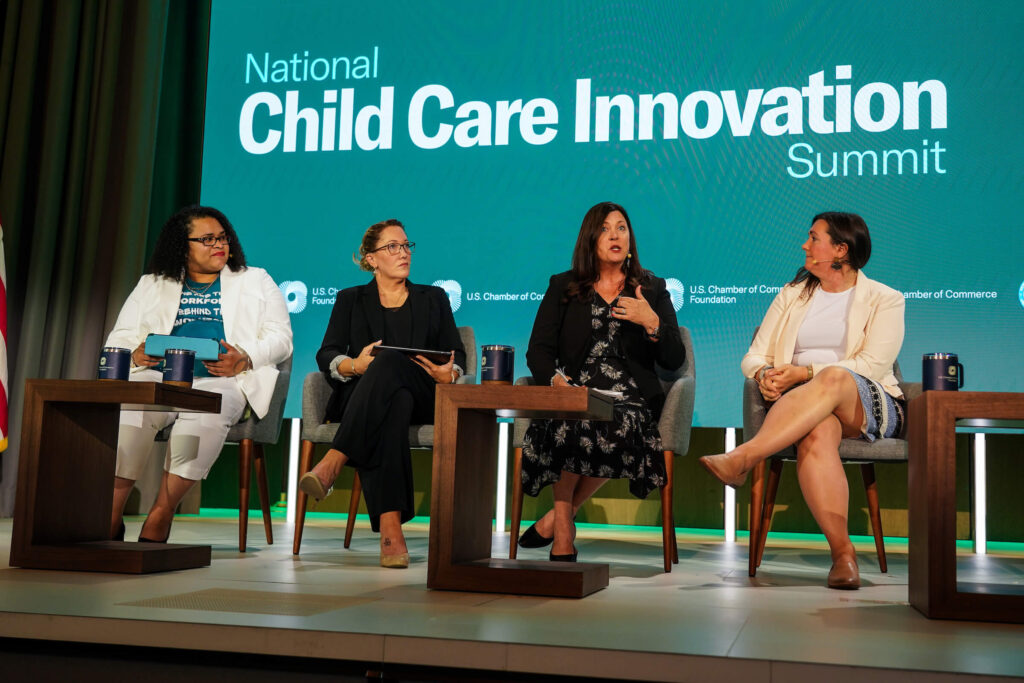
Photo courtesy of U.S. Chamber of Commerce
On Thursday, June 27, 2024, the U.S. Department of Commerce, the U.S. Chamber of Commerce, and the U.S. Chamber of Commerce Foundation hosted the “first-of-its-kind National Child Care Innovation Summit.” The summit brought together leaders from the public and private sector to discuss the vital role of child care for U.S. economic competitiveness, and Family Forward’s Executive Director, Candice Vickers, was invited to join a panel. There, she talks about our work in Oregon, specifically around House Bill 4098 from the 2024 legislative session.
Lessons from the National Childcare Innovation Summit with the U.S. Chamber of Commerce
At the summit, we had the chance to highlight Oregon’s game-changing House Bill 4098. We were invited to talk about this work here in Oregon not only because it addresses child care needs; it sets up a model that could inspire other states to tackle these issues head-on. Here’s a closer look at what makes this legislation so groundbreaking and how it could impact child care across the country.
What is HB 4098?
Family Forward Oregon was at the forefront of passing House Bill 4098. HB established the CHIPS Child Care Fund to support parents working in semiconductor industry.
Here’s the crux of it: Instead of each business trying to sort out its own child care solutions—something that’s often complicated and costly—businesses contribute to the CHIS Child Care Fund. “The Oregon CHIPS Child Care Fund directs Business Oregon to work with the Bureau of Labor and Industries (BOLI) to build off of the agency’s existing successful Apprenticeship-Related Child Care (ARCC) program to help fund child care for workers in the semiconductor supply chain. House Bill 4098 also directs funding to the existing Business Oregon Child Care Infrastructure Program to help support critical child care investments in regions where CHIPS Act investments are being made.” (Governor’s Office Newsroom)
Why This Model Works
House Bill 4098 brings a lot to the table:
- Helping Businesses and Employees: Businesses are spared the headache of creating their own child care solutions. Instead, they contribute to a shared fund that supports a broader child care infrastructure. This helps businesses keep their employees and attract new talent by addressing a major need—affordable and accessible child care.
- Strengthening Child Care Services: The bill boosts current child care programs, making them more capable of meeting increased demand. For example, it provides child care payments for up to five years for trade apprentices, which has already led to better completion rates and more diverse workforces.
Key Takeaways
- Child Care Is Complex: It’s not just about providing a service; it’s an intricate field with specific standards and needs. Addressing it requires understanding its economic and community impacts, not just its immediate logistics.
- Broad Impact: The child care crisis affects not just families but the whole economy. We need to involve both businesses and child care experts in finding solutions. These experts, who are often overlooked, are essential for making effective decisions.
- Collaboration is Key: Working together across public and private sectors is crucial. By combining resources and tapping into various funding streams, we can make a bigger impact. This also means integrating child care support into broader community and economic strategies.
Centering the Voices of Caregivers
One of the most important points made at the child care innovation summit was the need to include caregivers in these discussions. They are often left out of the policy-making process, even though they play such a crucial role. Moving forward, it’s vital to ensure their voices are heard and valued in shaping child care policies.
In short, Oregon’s House Bill 4098 provides a fresh, practical approach to child care that could serve as a blueprint for other states. It’s about making the most of existing resources and fostering collaboration to create solutions that work for everyone. If we take these lessons to heart and continue to prioritize the needs of caregivers, we can make real strides in solving the child care crisis.
—
Watch Candice and her co-panelists below!
